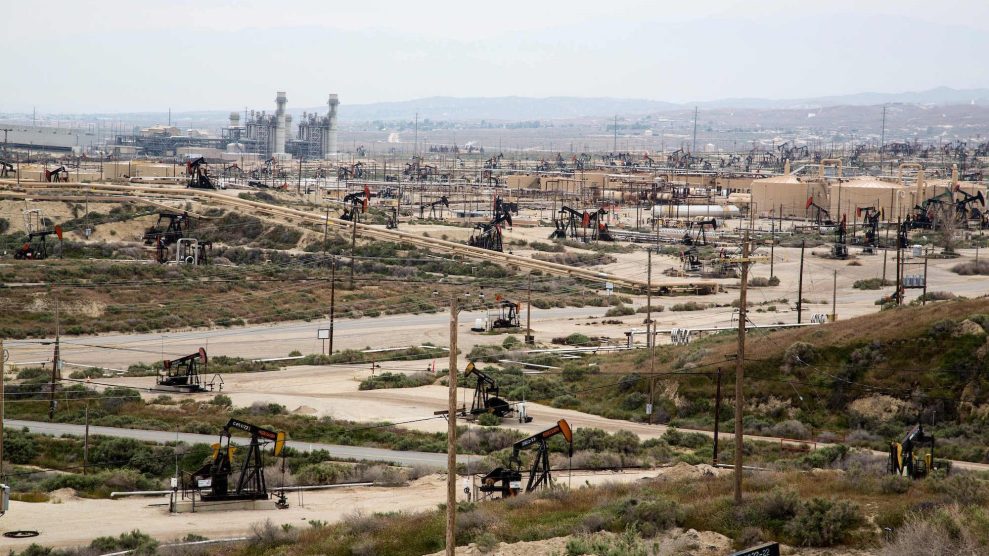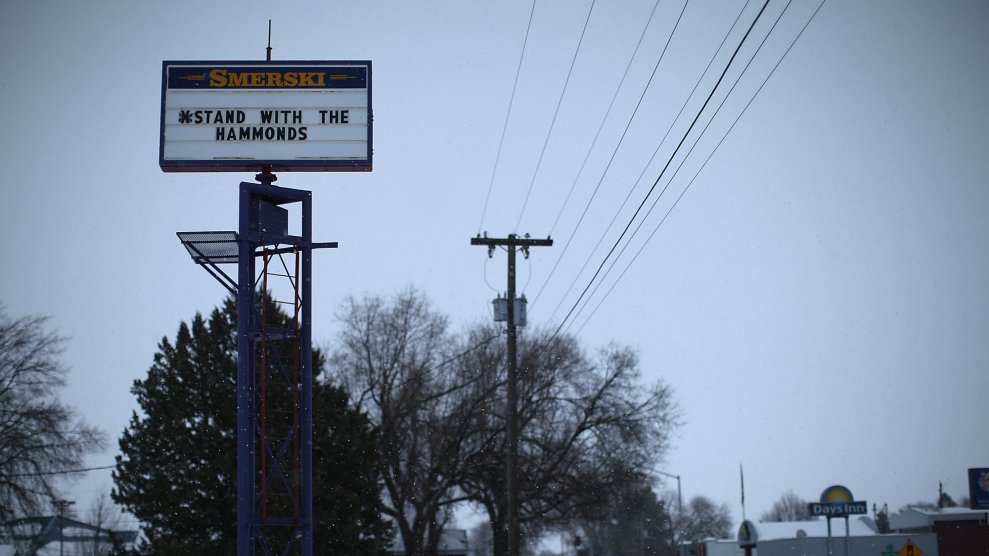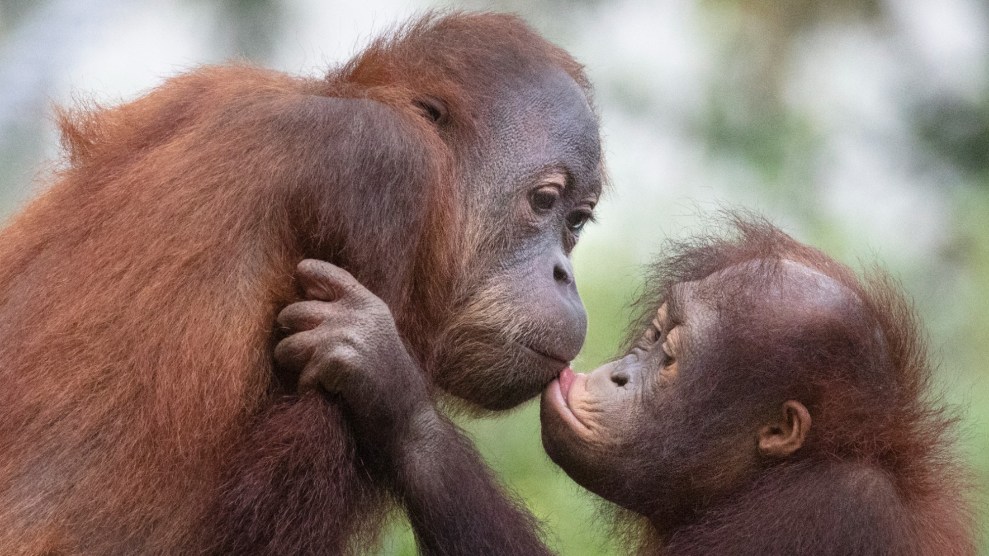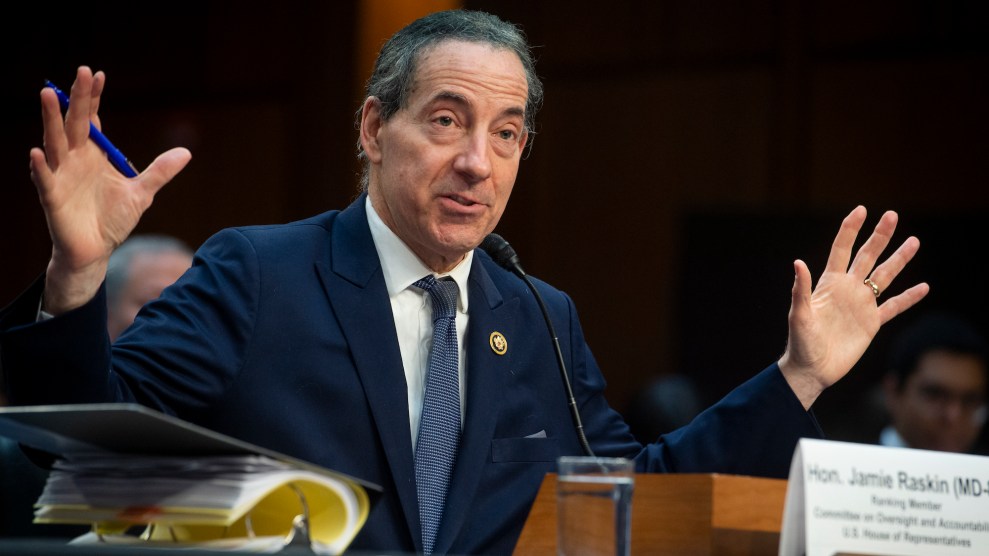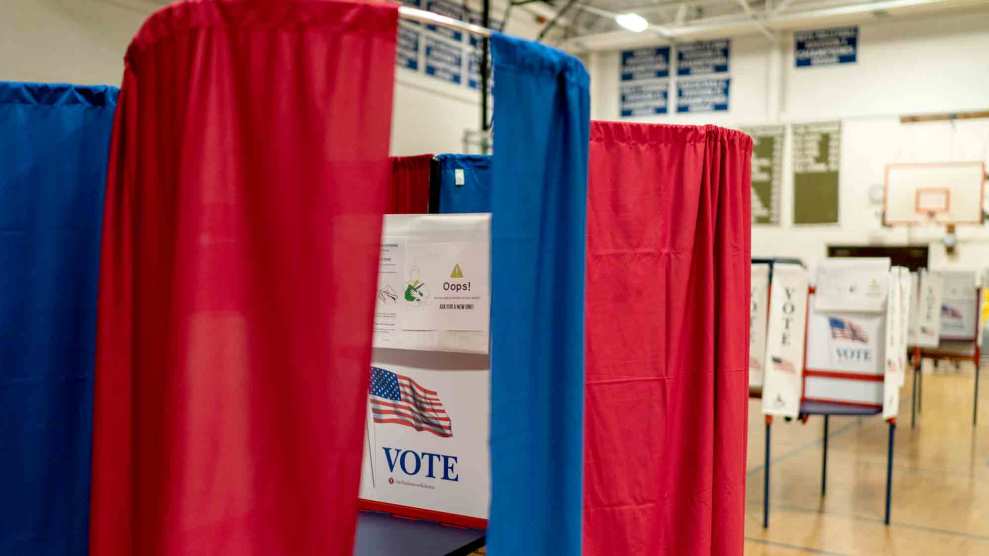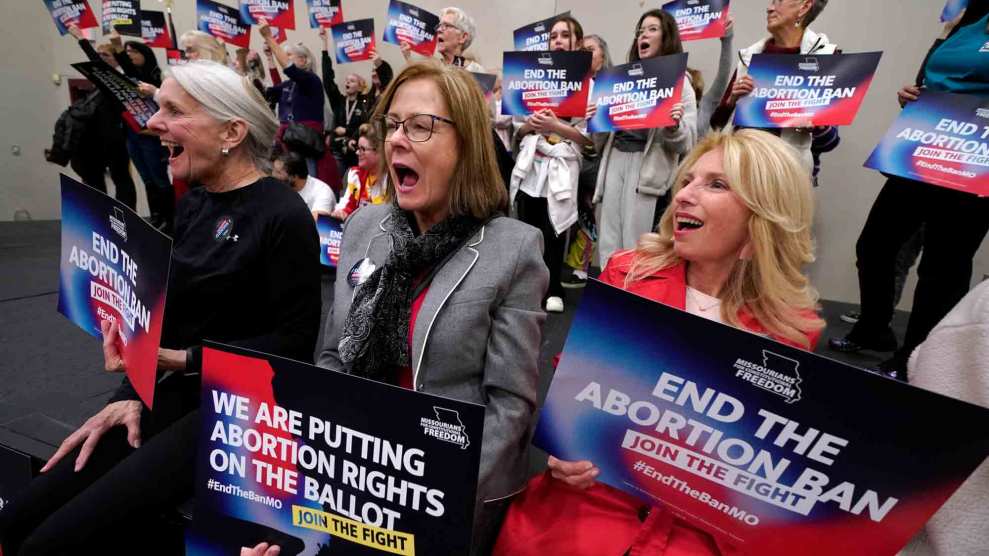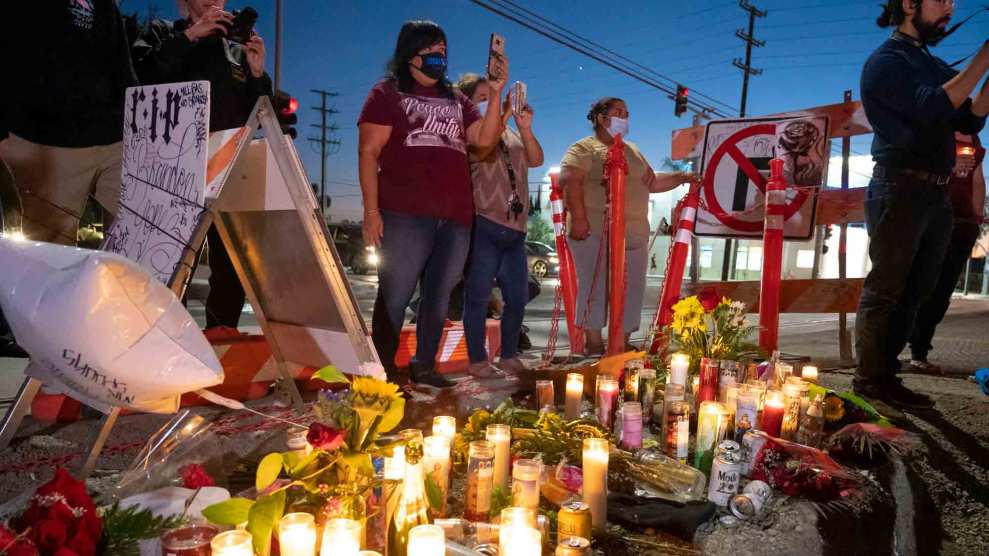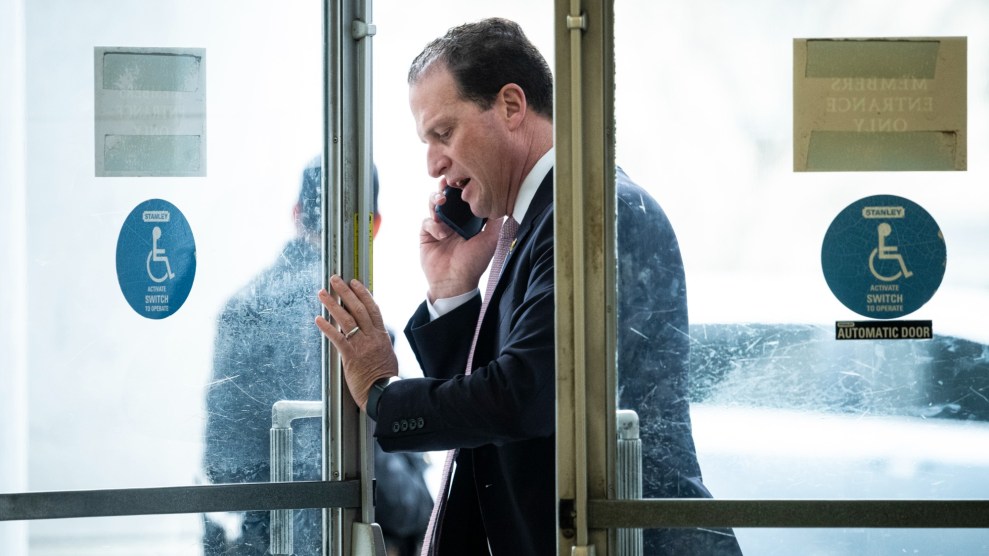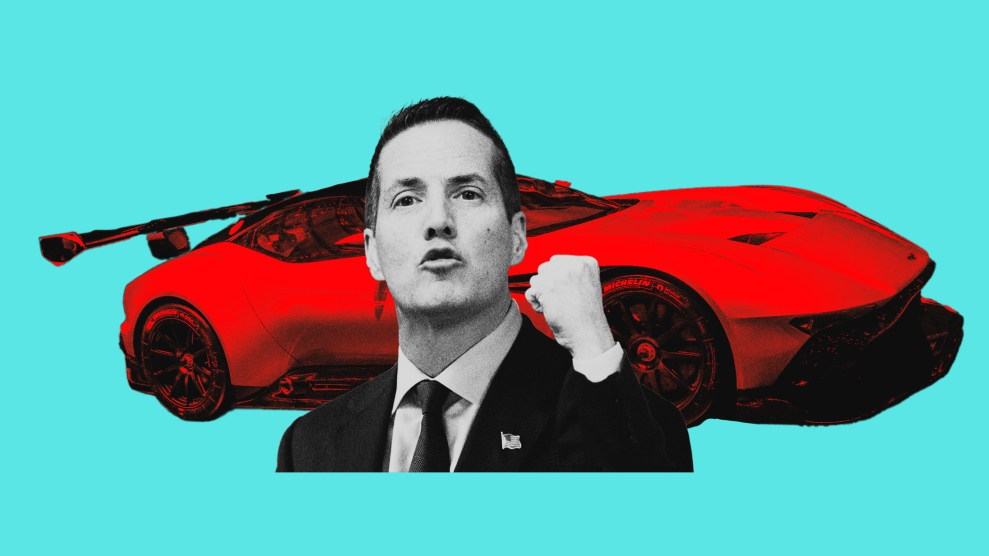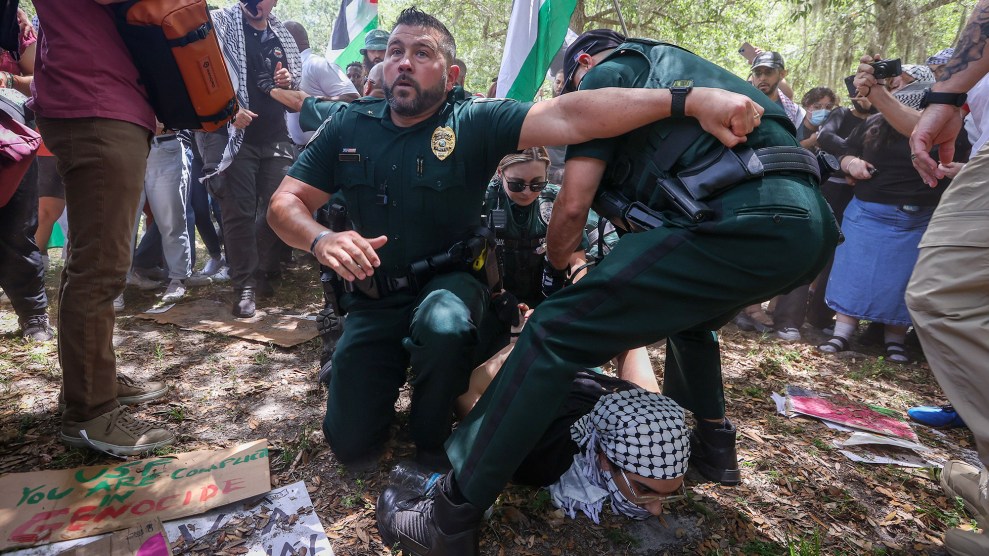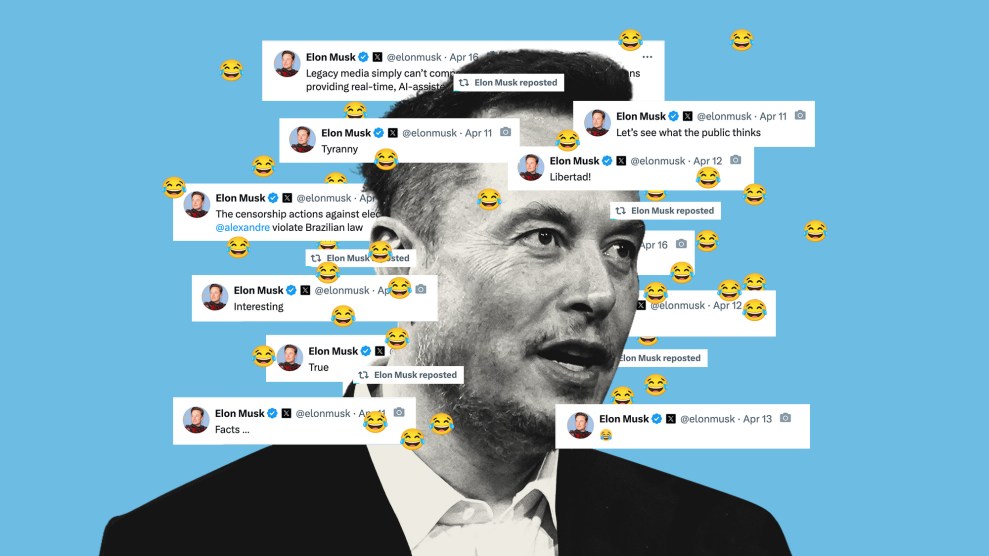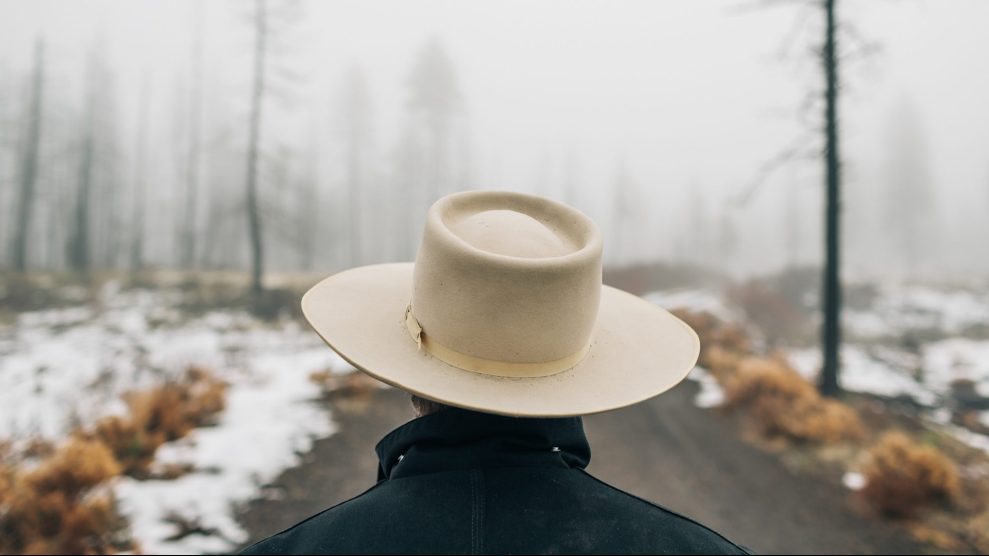
In 2015, Danny Brown discovered his friend, Dave Ruhl's burnt corpse lying among the lava rocks after the Frog Fire erupted in Modoc National Forest in northern CA. For the past 4 years, Danny has not only battled PTSD and the effects of that traumatic day but also the BLM after they forced him into a medical retirement.Michael Hanson/HCN
This piece was originally published in High Country News and appears here as part of our Climate Desk Partnership.
An hour or so before dawn in late July 2015, just south of the California-Oregon border, Danny Brown turned off the highway into the Modoc National Forest and headed toward a menacing glow of flames to the west. As he drove through a labyrinth of dirt logging roads, the smoke thickened in the beams of his headlights. At 46, Brown had been a wildland firefighter with the Bureau of Land Management for 14 seasons. He was a leader, reliable and steady. Within hours, all of that would change.
Brown was not scheduled to take charge on the Frog Fire until later that morning, but he headed there early because Dave Ruhl, his friend and fellow firefighter, was missing. Ruhl had been one of the first on the scene, and when a change in the wind caused a sudden blowup, his team lost radio contact with him.
Brown and Ruhl had known each other for 12 years, crossing paths on fires across the Western United States. But it wasn’t until they were both detailed to the Modoc with the Forest Service that summer that they became close. They worked out of separate guard stations, but on slow days they’d each drive an hour to meet up somewhere in the woods and have lunch.
When Brown reached the fire, he parked his truck near a group of pale green Forest Service fire engines huddled in the darkness. The fire was raging, so Brown and others searched its edges, shouting Ruhl’s name over the roar of burning timber. At first light, they fanned out in the devastation left behind by the blowup. Just after 9 a.m., some young firefighters from Arizona called out: They had spotted the charred remains of Ruhl’s body.
By the time Brown reached his friend, the others had headed back to their crews. As he stood there alone, waiting for the ambulance and law enforcement, something inside him snapped.
He had seen death before. Wildland firefighters are considered “all risk” emergency responders because of their extensive and versatile training; on previous calls, Brown had responded to a car accident, a plane crash and a suicide. But it wasn’t the sight of Ruhl that uncoupled some vital gear in Brown’s brain, turning him into a jumpy, irascible man for years afterward. It was the surprisingly sweet smell. Brown hadn’t eaten since the night before, and the scent of the seared flesh made his stomach growl.
In an instant, the primal wrongness of that response played havoc with his psyche. “I know we’re meat eaters or whatever, but that was not natural,” he later recalled. “We’re not cannibals.”
The nightmares began that night, shrinking Brown’s sleep to a few tortured hours. Always the same dream: The two of them sit in a guard station, laughing, but Ruhl is a burned husk. Brown tells his friend that this frightens him. Then he wakes up.
Other, more conspicuous symptoms followed. Whenever Brown’s senses told his brain that something was on fire, he gagged uncontrollably. The smell of smoke and the oscillating tone over the Forest Service radio that announces a new fire call had the same effect. He had to leave the house when his wife was cooking meat.
Almost five years after Ruhl’s death, I met Brown at a Starbucks in Klamath Falls, Oregon, near his home on the outskirts of Bonanza, a tiny farming town. As he sipped his coffee, recounting that day and everything that followed, I could see the toll it had taken on him.
He started but rarely finished sentences. His icy blue eyes alighted restlessly on random objects in the room. His fingers twitched. Every 15 minutes, it seemed, he cycled from calm to manic. “This all makes me feel weak-minded,” he told me. “How do some people that have been through this go on, and stay in fire and not be bothered?”
The trauma Brown sustained that day could happen to any wildland firefighter. It drove him out of the career he loved and the community that came with it, and to his agony it limited his ability to support his wife and their three children. He was eventually diagnosed with chronic PTSD—post-traumatic stress disorder—and in his most desperate moments, he thought about taking his life. Adding to his suffering was the feeling that he had been abandoned by the government that put him in harm’s way.
The first thing Brown did after finding Ruhl’s body was to retrace his friend’s last footsteps. Brown knew there would be an investigation, but he wanted to see for himself how that night had unfolded. He backtracked the meandering boot prints, now dusted with ash; Ruhl would have been angling for the best view as he directed water drops from a circling helicopter. Then the wind changed direction, the fire exploded, and a wall of flames 80 feet tall ripped toward him. Brown found a single boot print marking the moment Ruhl realized what was happening, the toe dug into the ground as he tried to outrun the flames.
Brown followed Ruhl’s path, which he calls “Dave’s last walk,” twice that day. In the months and years to come, he returned to the burned forest again and again, sometimes four times a week, sometimes in the middle of the night. He can’t say why, exactly. Maybe it’s a canker sore of guilt he can’t stop bothering—if he’d been there, he could have warned Ruhl about the dangerous shift in the weather. Maybe he’d have been with him and died that day, too. Perhaps to atone, and because it’s all he can do now, he goes to the forest to keep Ruhl company. “I kind of feel like that’s where he is,” Brown told me, “and it’s lonesome.”
For many PTSD patients, revisiting the details of a trauma can be healing. If a professional therapist guides the process, the patient can learn to deconstruct the negative thoughts and feelings that come up whenever the experience is relived, redirecting them into less harmful channels. But Brown—revisiting Ruhl’s death on his own—could be merely deepening his wounds. The kind of treatment he needs was not provided by his employer, the federal government. In fact, he’s had to fight for what little help he’s received.
The BLM employs roughly 3,000 wildland firefighters every year, the Forest Service another 10,000. Thousands more work for other federal and state land-management agencies. The government doesn’t track the incidence of post-traumatic stress among them, citing privacy considerations, but anecdotal evidence suggests it’s common. In a 2018 study that surveyed 20 wildland firefighters, for example, 11 reported having had “clinically significant” suicidal symptoms.
There are plenty of reasons why. The job involves a level of danger on a par with military combat, but the threats—smoke, falling trees, vehicle accidents, not to mention fire itself—are often even more sustained and relentless. Exhaustion and separation from loved ones compound the mental toll. For months, firefighters endure these conditions, filled with adrenaline and a sense of purpose, surrounded by close friends who are experiencing the same thing. Then, at the end of the season, they have to go home and be spouses, parents, ordinary citizens. Like returning combat veterans, they often struggle to adjust to peacetime life, and many turn to alcohol and drugs.
“We see a lot of bad things in winter,” said Nelda St. Clair, a consultant who coordinates fire-specific crisis intervention and mental fitness for federal and state agencies. “People lose their sense of belonging, their identity. They lose their structure. That’s when we tend to worry about them.”
Longer, more intense fire seasons are pushing firefighters harder each year, St. Clair said, and the threat to their mental health has been growing. Middle managers like Brown, who work through the off-season and shoulder the psychological burden of sending subordinates into harm’s way on ever-larger and more dangerous fires, are especially vulnerable.
There are no official numbers, but St. Clair tries to keep track of how many wildland firefighters take their own lives each year. Her unofficial tally suggests as many die by suicide as in the line of duty.
Over the past few years, the wildland firefighting community has become increasingly aware of trauma exposure within its ranks, but the federal and state agencies that employ firefighters remain ill-prepared to handle cases like Brown’s. Treatment options are limited and difficult to access. Rather than help traumatized employees recover, many say the government offers them an impossible choice: Take the injury in stride, or go work somewhere else.
In the weeks after Ruhl’s death, the Forest Service organized crisis intervention sessions for his coworkers, common procedure after a fire fatality. The sessions, officially called Critical Incident Stress Management, or CISM, involve a visit from a team of peer supporters—fellow firefighters who understand the job’s unique culture and challenges and are trained in discussing trauma—and at least one licensed clinician. Over a few days, the team describes common responses to a traumatic event and teaches general coping methods, referring firefighters for more care if necessary. Done well, the sessions are effective in helping most survivors. But trauma affects different people differently, and symptoms may not appear for weeks, months or years.
“CISM is not therapy; it’s psychological first aid,” said Jim Duzak, a nurse practitioner in psychiatry who was a smoke jumper for three decades and now works on CISM peer-support teams. “It’s like learning how to put a splint on a broken bone, but you’re not the surgeon.”
It wasn’t until halfway through the next fire season, when he was working for the BLM again, that it became clear Brown needed the psychological equivalent of a surgeon. Scott Havel, Brown’s longtime friend and direct supervisor at the time, heard from crew members that Brown was acting strangely whenever they were dispatched to a fire. When the next call came in, Havel followed Brown’s fire engine to see for himself. Brown pulled over and started dry-heaving by the side of the road. Then he got back in and drove to the fire.
“Of course, that threw some red flags up for me,” Havel said. “After the fire, we got back to the station, and I sat down and visited with him, and he goes, ‘It happens on every fire.’ ”
After that, Havel kept Brown off the fireline for the remainder of the season, giving him administrative tasks instead. Havel and Abel Harrington, another close friend and supervisor of Brown’s, say they didn’t know what to do next. “We don’t train for this. We don’t know enough about it,” said Harrington. “I’m getting on Google, and I’m trying to figure out what the heck’s going on.”
Havel and Harrington suggested that Brown see a therapist. He knew they were right—sheer grit could not suppress what was happening to him. But there aren’t a lot of therapists who specialize in trauma in rural areas, and the closest psychiatrist Brown could find who would take his insurance was 100 miles away in Ashland, Oregon. He made the drive, and the therapist immediately diagnosed him with post-traumatic stress disorder.
After a few visits, Brown’s insurance company told him it would stop covering his therapy. If his PTSD was an on-the-job injury, his employer would have to cover treatment.
So Brown turned to the Employee Assistance Program, or EAP, a benefit for federal workers that offers everything from work-related stress counseling to financial advice. It’s not intended for specialized or long-term treatment, however; employees get only six free sessions. After hearing Brown describe his symptoms, his EAP counselor referred him to an outside trauma specialist. But he couldn’t afford to pay for one out of pocket.
Brown’s only other option was workers’ comp, which would turn out to be the hardest part of the struggle. The federal Office of Workers’ Compensation Programs (OWCP) is notorious among federal firefighters; many believe it focuses more on weeding out fraudulent claims than paying legitimate ones. Proving a psychological injury and linking it directly to something that happened at work is especially difficult. Although he had already been diagnosed with PTSD, Brown had to drive five hours to Portland to receive the same diagnosis from an approved doctor, who added the words “severe” and “chronic.” It took months for Brown to get an answer about his claim.
In response, an agency spokesperson said OWCP is “strongly committed to timely and accurate adjudication” of claims, and the majority of them “are accepted and paid quickly.”
As is true with most patients seeking mental health treatment, the process was complicated by Brown’s condition. His attention was scattered; he was easily distracted by the emotions—rage, fear and confusion—he struggled to keep at bay. Havel and Harrington tried to help, especially with navigating the workers’ comp bureaucracy, but they both found Brown an unreliable source of information.
“We almost had to be in the room to get what was happening, and what avenues were being taken,” said Harrington. “The cognizant thought in putting that all together, it just wasn’t clicking.”
The workers’ comp office finally approved Brown’s claim in the fall of 2016. But he was not given a list of the doctors it would cover, he said, even after he called repeatedly asking for one. Eventually, enraged by the ordeal, he gave up.
That winter, the second after Ruhl’s death, Brown withdrew, holing up alone in his tiny guard station, miles from the nearest town. He’d close his office door, not answer the phone, and spend the entire day watching TV. “I was a wreck,” he said. “My innards were just spinning in circles, and I didn’t know which way to go.”
He started avoiding his co-workers, even his closest friends. If he needed to stop by the district office, he’d sneak in through the back door and be gone before anyone knew he was there. “I watched somebody I’d known for 15 years disappear before my eyes,” Harrington said. “If I never have to go through something like this again in my career, I am a far better person for it.”
By the spring of 2017, it was clear to both him and his colleagues that Brown could no longer work in fire.
In April, by way of mutual agreement, the BLM revoked the “red card” certification that allowed Brown to do his job. He had no desire to see the fireline again, and he knew his condition could endanger his colleagues. “Fire is dangerous, man,” he told me. “When you’re standing there staring off into space for 10 minutes and not even realizing you did it, you’re gonna get somebody killed.”
Brown asked the BLM for a job packing firefighting gear or loading air tankers, something that would give him overtime hours—half his income in a busy fire year—without triggering his symptoms. But the options were limited. Brown’s district manager offered him a detail as a “range tech” looking after BLM-owned ranchland in the area. He’d get the same base pay as his fire job, but no overtime. Jessica Gardetto, chief of external affairs for the BLM’s Fire and Aviation Program, clarified that overtime is never guaranteed for firefighters. “That’s part of the job,” she said. “They know that when they sign up for it.” More devastating was the fact that Brown would lose his fire retirement — essentially long-term hazard pay that amounted to hundreds of dollars extra per month for the rest of his life.
The BLM’s response followed government laws and regulations, according to Brown’s district manager at the time, E. Lynn Burkett. She has since moved on to the Forest Service and no longer speaks in an official capacity for the BLM. “The agency did everything we could to support Danny, and to offer him work that would not expose him as much to firefighting so that he could heal,” she said. “Many times people do not understand what the agency can and cannot do, no matter how much you explain it to them.”
From Brown’s perspective, the loss of his fire retirement would be a profound betrayal. “I’m a 20-year employee with these people, and they act like I was a two-day employee,” he said. “I don’t want it to seem like it’s all about money, but I’ve got to take care of my family.”
Desperate to keep his benefits, Brown emailed top BLM officials in Washington. “I feel I am standing alone,” he wrote then-Acting Director Michael Nedd. He received sympathetic responses, but no change to his situation. “I was at the point where I thought, ‘If I just kill myself, at least my wife and kids will have my life insurance and all my benefits.’ ”
Months earlier, frustrated by the bureaucracy, Havel and Harrington had contacted the Wildland Firefighter Foundation, hoping it could help Brown. The Boise, Idaho-based nonprofit was formed in 1999 to support the families of firefighters killed or injured in the line of duty. Over the last few years, that mission has grown to include supporting firefighters themselves. The WFF has helped hundreds get specialized mental health treatment when they needed something beyond the counseling services offered through the Employee Assistance Program, or when workers’ comp failed them. “We fill a gap that the government can’t,” said Vicki Minor, the organization’s founder, who is now retired.
Fire culture itself—known for its “rub some dirt so it doesn’t hurt” mindset—is often a barrier, Minor said. Despite some recent improvement, there is still a chronic stigma attached to mental health and a lack of education about it. Firefighters also worry about losing their jobs if they admit they’re struggling and ask for help.
“It’s not safe for them to tell people they’re having mental trouble,” said Minor. She and others in the firefighter support field believe that, with appropriate treatment, psychological trauma doesn’t have to end careers the way it ended Brown’s. But the government leaves little room for alternatives.
The closest trauma specialist the WFF found for Brown was three hours away. As a stopgap, it connected him with St. Clair, the peer support coordinator. Between July and December of 2017, St. Clair spent hours talking Brown through panic attacks over the phone.
“Danny was in such trauma then,” she said, “he sometimes couldn’t even put a sentence together.” Once, listening to the sound of his gagging, she almost called 911. “There were nights when I was terrified.”
The WFF also helped Brown get a lawyer, who sent letters to BLM officials. Soon after, strings that were invisible to Brown had been pulled, and he had his retirement back.
Asked why the BLM reversed its decision, spokespersons said federal privacy laws prevent the agency from discussing anything related to a specific employee. Derrick Henry, a spokesperson at the agency’s Washington, D.C., headquarters, added that “the BLM consistently follows applicable policies for on-duty incidents and personnel matters.”
The effects of Brown’s PTSD have continued to ripple through every aspect of his life. His wife filed for divorce last August. “I think eventually she just got tired of not having a husband,” he said. After Brown lost his overtime pay, she had to get a job, but their combined income still wasn’t enough to cover the family’s bills. Brown now works three jobs, cutting hay and helping local ranchers vaccinate cattle in addition to his range tech duties for the BLM. He briefly pumped gas this past winter but found it didn’t pay enough to justify the time. In a few years, Brown will have put in enough time to take his fire retirement. But he doesn’t think he’ll be able to afford to stop working for the BLM.
The federal agencies that fight wildland fire are starting to realize they have a trauma problem, albeit too late to help people like Brown.
For a long time, psychological trauma wasn’t openly acknowledged as a potential side effect of firefighting. Duzak, the CISM clinician, survived a burnover in 1979, when he was a young firefighter. A crew boss was killed, and he helped load the charred body into a helicopter. “We got pulled off the fireline for about 10 hours, then got sent home,” he remembers. “No one talked to us about what happened.”
The government has recently taken steps to change that approach. Education about the psychological risks of fire work and how to recognize the warning signs of trauma is now part of standard firefighter training. In 2019, a wildland firefighter Mental Health Subcommittee was established by a coalition of federal and state land-management agencies, working with the International Association of Fire Chiefs and the US Fire Administration, to explore ways to improve support. The BLM, with other agencies, has adopted stricter standards for Critical Incident Stress Management, making it less likely that cases like Brown’s will fall through the cracks in the future. By all accounts, the government is getting better at encouraging firefighters and their managers to communicate about mental health, both before and after it becomes an issue.
But encouraging employees to talk about mental health is not the same as providing the resources for healing. Front-line supporters like St. Clair say that without more robust long-term treatment and work flexibility, the government is leaving many traumatized firefighters to struggle on their own.
St. Clair has begun to facilitate telemedicine—connecting firefighters with trauma specialists by phone or video—a boon for those who live in remote areas. “The issue is, how do people pay for it?” she said. Workers’ compensation covers telemedicine, but St. Clair said few firefighters have that option if they haven’t gone through the arduous process to prove a mental health injury.
Brown eventually got a list of doctors that his workers’ comp claim would pay for. There were two in Klamath Falls, the only city within reasonable driving distance of his home. He tried both, but never went back. The therapists didn’t seem to be listening to him, he said. “All they want to do is give you pills. Nobody can tell you why.”
In late 2017, after more than a year and a half of failed attempts to get treatment, Brown’s family doctor referred him to a therapist who administered Eye Movement Desensitization Processing, a common PTSD treatment that seeks to rewire damaged pathways in the brain by having the patient recall the trauma while making repetitive eye or hand movements. The treatment helped. Brown liked the therapist, and he felt the crushing weight of his condition lift while he was in her office. But workers’ comp wouldn’t cover her fees, and then she moved away.
Brown has since given up on seeking treatment. The travel and the search for someone who can help seem like more trouble than they’re worth. “I’d rather be a nervous wreck the rest of my life,” he said. “I have come to the firm realization that this is how life’s going to be.”
One foggy morning in early December, Brown took me to the place where Ruhl died. On the drive, as we went over the past five years, he seemed to stifle a cough, small at first, then catching in his throat more and more frequently as he talked. By the time we hit the maze of dirt roads in the Modoc, he was visibly agitated. He got turned around; much of the timber killed by the fire had been salvaged, disfiguring the tableau of his memory. But eventually, Brown’s recollection prevailed; the pullout where he had parked his truck was unmistakable.
The place was a black remnant of a forest, stark against an inch of snow on the ground. Beyond a hundred yards, the burned ponderosas disappeared into the fog, which was nearly as thick as the smoke had been five years ago. Brown retraced his friend’s last steps for the umpteenth time, taking me through like a tour guide.
The spot where the body was found is marked by a plaque. Brown started to tell me it was made by Ruhl’s hometown, Rapid City, South Dakota, using stone from Mount Rushmore. In midsentence, his body seemed to constrict, cutting off his last word. “About to have me an attack,” he said. But he kept talking, pushing through the convulsions.
Later, as we drove away, Brown’s mind circled back to the fact that he’d had trouble finding the place. It was gnawing at him. “I start to wonder if I should put little markers on the trees for me for in 20 years, when I come down here,” he said. “Hell, another fire could come through here, and none of this will be the same.”
